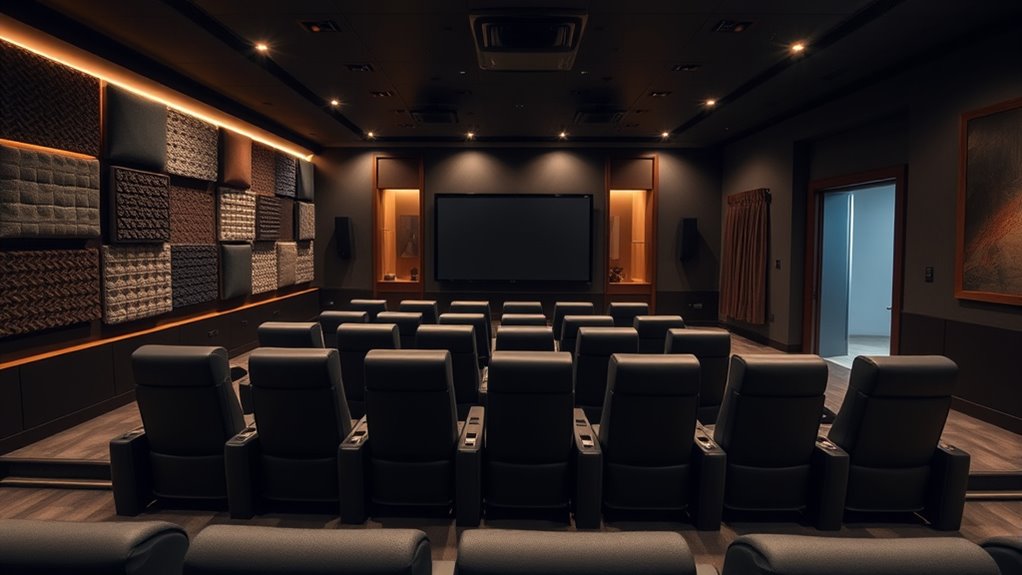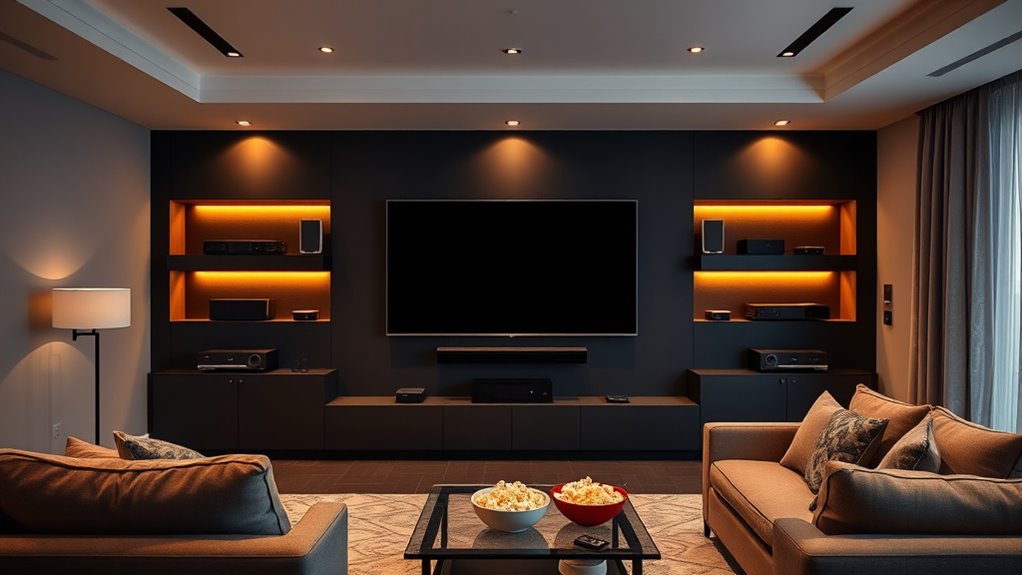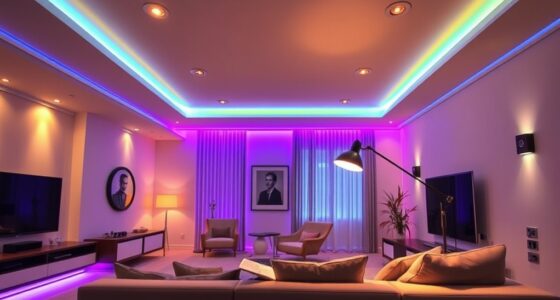To establish a home theater and multi-room audio system, begin by evaluating your space and planning your layout carefully. Choose high-quality display and audio equipment, then select compatible sources like Blu-ray players or streaming devices. Proper wiring and cable management ensure a neat setup, while acoustic treatments improve sound quality. Calibrate your system for peak performance, and don’t forget to explore smart controls. Keep learning the best techniques, and your setup will become truly immersive.
Key Takeaways
- Assess and plan your space for optimal acoustics, lighting, and furniture placement to enhance viewing and listening experiences.
- Select high-quality display and audio equipment, then calibrate for accurate color, sound balance, and optimal performance.
- Organize and conceal wiring using cable management techniques to maintain a clean, safe, and clutter-free setup.
- Choose compatible sources (Blu-ray, streaming, gaming) supporting current formats like 4K, HDR, and Dolby Atmos for future-proofing.
- Design a multi-room system with appropriate speakers, zones, and controllers for seamless audio distribution and user control.
Assessing Your Space and Planning Your Layout

Before setting up your home theater, you need to carefully assess your space and plan your layout. Start by measuring the room’s dimensions, noting windows, doors, and electrical outlets. Consider how room lighting affects your viewing experience; dimmable lights or blackout curtains help diminish glare on the screen. Think about furniture placement to maximize comfort and viewing angles. Position seats so everyone has a clear view of the screen without obstructing pathways or access points. Avoid placing furniture directly in front of windows or light sources, which can cause unwanted reflections. Keep in mind the room’s acoustics and how furniture placement can help absorb sound or reduce echo. Additionally, understanding the importance of contrast ratio can guide you in selecting the right projector to ensure deep blacks and bright highlights, enhancing your viewing experience. Proper planning ensures your home theater will be immersive, comfortable, and functional. For optimal sound quality, consider soundproofing options to minimize external noise and improve audio clarity.
Choosing the Right Display and Sound Equipment

Selecting the right display and sound equipment is essential to creating an immersive home theater experience. Start with a high-quality display; consider size, resolution, and viewing angles. Proper display calibration guarantees colors are accurate, and images are sharp, enhancing overall picture quality. For sound, choose speakers that suit your space, paying attention to speaker placement to optimize audio clarity and surround sound effects. Proper placement—such as positioning front speakers at ear level and avoiding obstructions—makes a significant difference. Balance is key: avoid overwhelming sound or dull visuals. Think about your room’s acoustics and lighting conditions when selecting equipment, and ensure your display and speakers complement each other for a cohesive, engaging experience.
Selecting Audio and Video Sources

When choosing your audio and video sources, you need to make certain they’re compatible with your setup and support your preferred content formats. Consider how you’ll connect devices through appropriate cables and ports for a seamless experience. Also, check that your sources can handle the resolution and media types you plan to enjoy. Be aware of any device compatibility issues that could affect your ability to stream or display media effectively. Additionally, ensure that the sources include features like support for high-definition content to optimize your viewing and listening experience. Verifying that your sources support multimedia formats can help prevent playback problems and ensure smooth operation across devices. Regularly assessing the organization of media files can streamline your setup and improve overall performance. Furthermore, choosing sources with safe and energy-efficient features can enhance safety and reduce power consumption in your home theater system.
Source Compatibility Options
Choosing the right audio and video sources is vital to guarantee your home theater functions seamlessly. You need to consider source formats, like HDMI, component, or composite, to ensure your devices work together smoothly. Compatibility standards such as HDCP, HDR, and 4K support are essential for proper playback and future-proofing your system. Verify that your source devices, like Blu-ray players, gaming consoles, or streaming boxes, match your receiver’s supported formats. This helps prevent issues like incompatible resolutions or audio delays. Also, check if your sources support the latest standards to keep your setup current. By understanding source formats and compatibility standards, you’ll avoid frustration and ensure a seamless, high-quality entertainment experience. Additionally, being aware of anime movies can inspire you to create a cozy viewing area with themed decor and comfortable seating options. Incorporating knowledge of video resolution standards can further enhance your setup by ensuring your display and sources deliver the best possible picture quality. Considering audio configurations is also crucial for optimizing sound quality across multiple rooms. Paying attention to home theater design principles can help optimize your space for better acoustics and viewing comfort. Recognizing personality compatibility can also help tailor your home environment to suit your preferences and enhance your overall entertainment experience.
Connectivity and Cabling
To guarantee your home theater delivers crisp visuals and immersive sound, focus on the right connectivity options and cabling choices. Ensuring peak signal transfer involves selecting high-quality HDMI cables, considering wireless connectivity for less clutter, and planning efficient power distribution to prevent outages. Proper cabling minimizes interference and boosts overall performance. Use shielded cables where necessary and keep cables organized for safety and aesthetics. Also, evaluate your system’s compatibility with different connection types, like optical or analog outputs, to maximize flexibility. Good cable management not only improves the look but also enhances reliability. Additionally, choosing the right network security measures can significantly improve cybersecurity and protect your home network from vulnerabilities. Incorporating Data-driven strategies can help you troubleshoot and optimize your setup based on performance metrics. Staying informed about the latest automation technologies can further enhance your system’s integration and ease of use. Remember, a solid foundation in connectivity and cabling sets the stage for an exceptional viewing and listening experience.
Content Format Support
Selecting the right audio and video sources is essential to guarantee your home theater can handle a variety of content formats seamlessly. You need to verify your system supports different audio formats to deliver immersive sound, whether it’s Dolby Atmos, DTS:X, or uncompressed PCM. Streaming compatibility is equally important, allowing you to access content from services like Netflix, Hulu, or Spotify without issues. Look for sources that support common video formats such as 4K, HDR, and Dolby Vision, which enhance picture quality. Compatibility with multiple input types—HDMI, optical, and digital audio—is crucial for connecting devices effortlessly. Additionally, understanding the audio format support of your devices ensures you get the best sound quality for all types of media. By choosing sources that handle various audio formats and streaming protocols, you’ll create a versatile setup that delivers high-quality entertainment across all your content. Ensuring content format support is comprehensive will future-proof your system against evolving media standards. Incorporating device compatibility considerations can further streamline your setup and improve overall user experience. Moreover, utilizing AI-driven content analysis can help optimize your source selection for better performance and adaptability. Implementing automatic format detection can also simplify switching between different media types and reduce setup issues.
Designing Your Audio System for Multi-Room Functionality

Designing your audio system for multi-room functionality requires careful planning to guarantee seamless sound distribution throughout your home. Start by selecting wireless streaming devices that support multi-room audio, ensuring easy control from a single app. Proper speaker placement is vital; position speakers to maximize sound quality and coverage in each room. Consider the acoustics of your spaces and avoid obstructions that could hinder sound flow. Use zones or groups to customize volume and source settings per room. Additionally, choose a central hub or controller compatible with your devices for smooth operation. Keep in mind the balance between aesthetics and function to avoid clutter. Thoughtful planning ensures your multi-room system delivers consistent, high-quality audio experience across your entire home.
- Optimal speaker placement strategies
- Compatibility of wireless streaming platforms
- Zone configuration for customized control
- Acoustic considerations for sound quality
- Central hub or controller selection
Wiring and Cable Management Tips

Keeping your cables organized not only looks better but also makes troubleshooting easier. Use cable clips and ties to create a clean, structured layout that minimizes clutter. Concealing wiring behind walls or furniture helps maintain a sleek, professional look in your home theater. Incorporating cable management techniques can further simplify maintenance and enhance safety.
Organized Cable Layouts
Have you ever struggled to find the right cable or kept tripping over tangled wires? Organized cable layouts make setup easier and safer. To achieve this, plan your wiring before starting, ensuring each component has a designated path. Use cable ties or Velcro straps to bundle wires neatly, reducing clutter. Label cables for quick identification, especially when adjusting speaker placement or troubleshooting wireless streaming issues. Conceal cables behind furniture or along baseboards to keep the space tidy. Consider installing cable conduits or raceways for a sleek look and better protection. Proper organization not only enhances aesthetics but also prevents damage and simplifies future upgrades.
- Use cable ties or Velcro straps for bundling
- Label all cables for easy identification
- Conceal cables behind furniture or along baseboards
- Plan wiring routes ahead of installation
- Keep cables away from high-traffic areas for safety
Concealed Wiring Techniques
Concealed wiring techniques can substantially improve the look of your home theater by hiding unsightly cables and creating a clean, streamlined appearance. Using cable concealment methods, such as running wires through walls, ceilings, or raceways, helps keep your setup tidy. First, plan your wiring routes carefully, avoiding cluttered areas. Use in-wall rated cables and conduit to safely hide wires behind walls or along baseboards. Wall plates with built-in cable management features can also hide cables neatly while providing easy access. When installing, ensure you drill carefully and avoid electrical hazards. By implementing these concealed wiring strategies, you’ll achieve a professional look, reduce cable clutter, and enhance the overall ambiance of your home theater space.
Configuring Your Audio-Visual Components for Optimal Performance

To achieve the best audio-visual experience in your home theater, proper configuration of your components is essential. Start by optimizing speaker placement to ensure even sound coverage and clear dialogue. Use lighting control to create a cinematic atmosphere and reduce glare on screens. Adjust your display settings for sharp images and accurate colors. Connect your devices correctly, prioritizing high-quality HDMI cables for better signal transfer. Calibrate your audio system with test tones to balance volume levels and clarity. Finally, organize your cabling to prevent interference and maintain a clean setup.
- Fine-tune speaker placement for surround sound accuracy
- Set lighting levels for ideal viewing and ambiance
- Calibrate display settings for color accuracy
- Use high-quality cables to enhance signal quality
- Organize wiring to avoid interference
Integrating Smart Technologies and Control Systems

After optimizing your audio-visual components and organizing your cabling, the next step is to incorporate smart technologies and control systems that streamline your home theater experience. Voice control allows you to manage devices hands-free, making operation intuitive. App integration brings all your equipment into one interface, so you can adjust settings, select sources, or turn on devices with a tap. To visualize this, consider the following:
| Device | Control Method | Function |
|---|---|---|
| Smart Hub | App & Voice | Centralized control of all systems |
| Voice Assistant | Voice control | Hands-free operation of lights, AV, etc. |
| Smartphone App | App control | Custom scenes, device management |
| Remote Controls | Manual | Quick access to specific functions |
This setup creates a seamless, user-friendly smart home theater environment.
Setting Up Acoustic Treatments and Soundproofing

Achieving ideal sound quality in your home theater depends largely on effective acoustic treatments and soundproofing. To enhance acoustics, install acoustic panels strategically to absorb unwanted echoes and improve clarity. Use soundproof barriers around the room, such as mass-loaded vinyl or resilient channels, to prevent sound leakage. Proper placement of these materials can dramatically enhance your listening experience and minimize disturbances. Focus on key areas like walls, ceilings, and floors for maximum impact. Remember, balancing absorption and isolation is essential for a professional soundstage.
Effective acoustic treatments and soundproofing enhance home theater sound quality.
- Strategic placement of acoustic panels for maximum absorption
- Sealing gaps with soundproof barriers to block noise
- Using bass traps to control low-frequency resonances
- Installing door sweeps and window plugs for added soundproofing
- Layering materials for a tailored acoustic environment
Testing, Fine-Tuning, and Troubleshooting Your System

Once your system is set up, it’s time to test and fine-tune it for ideal performance. You’ll want to use calibration techniques to balance audio and video, troubleshoot connectivity problems, and enhance sound quality. Addressing these areas guarantees you get the best possible home theater experience.
System Calibration Techniques
System calibration is a crucial step to guarantee your home theater delivers peak sound and picture quality. Proper calibration ensures your speakers are correctly positioned and tuned for best performance. Start with precise speaker placement, positioning each speaker at ear level and equidistant from the listening area. Use calibration tools like a sound level meter or automatic room calibration systems to fine-tune settings. Adjust speaker levels, distances, and crossover points to balance sound across the room. Employ test tones and audio calibration discs to verify accuracy. Regularly revisit calibration as room acoustics or equipment change. Proper calibration minimizes sound imbalances, enhances clarity, and creates an immersive experience. Fine-tuning your system ensures you get the best possible audio and video quality from your home theater setup.
- Speaker placement adjustments for best sound
- Utilizing calibration tools effectively
- Balancing speaker levels and distances
- Correcting audio frequency responses
- Verifying calibration with test tones
Troubleshooting Connectivity Issues
After calibrating your home theater system, it’s important to verify that all components communicate properly and function seamlessly. Begin by testing each connection, including wired and wireless links. If you experience connectivity issues, consider wireless troubleshooting steps such as checking signal strength, resetting your router, or moving devices closer together. Ensure all firmware updates are installed on your AV receiver, smart devices, and wireless extenders, as outdated firmware can cause compatibility problems. Restart devices if needed, and re-establish connections to improve stability. If problems persist, verify that your network settings are correct and that no interference is disrupting signals. These quick checks help identify and resolve common connectivity issues, ensuring your system performs smoothly during movie nights.
Optimizing Audio Quality
To achieve the best audio quality, it’s vital to regularly test and fine-tune your home theater setup. Start by evaluating speaker placement, ensuring each speaker is positioned for ideal sound distribution. Fine-tuning involves calibrating your system’s settings to match your room’s acoustics, enhancing clarity and depth. Acoustic optimization may require adjusting speaker angles or adding sound-absorbing materials to reduce echo. Troubleshoot issues like uneven sound or background noise promptly. Consider using calibration tools or room correction software for precise adjustments. Remember, small tweaks can markedly improve your listening experience. Keep testing and refining your system to maintain peak audio performance.
- Proper speaker placement for balanced sound
- Room acoustics adjustments
- Calibration tools and software
- Sound equalization techniques
- Troubleshooting common audio issues
Maintaining and Upgrading Your Home Entertainment Setup

Regular maintenance is essential to keep your home theater performing at its best, and upgrading guarantees it remains current with the latest technology. Periodically check your equipment, update firmware, and ensure your wireless streaming devices are secure and functioning smoothly. When upgrading, consider new features like enhanced wireless streaming capabilities or improved speaker placement to optimize sound quality. Proper speaker placement enhances audio clarity and immersiveness, while regular cleaning prevents dust buildup. To better understand maintenance priorities:
| Action | Purpose | Frequency |
|---|---|---|
| Update firmware | Improve performance | Monthly |
| Check speaker placement | Maximize audio clarity | Annually |
| Clean equipment | Prevent dust buildup | Quarterly |
| Upgrade components | Keep system current | Every 2-3 years |
Staying proactive guarantees your setup remains reliable and up-to-date.
Frequently Asked Questions
How Do I Ensure My Wi-Fi Can Handle Multiple Streaming Devices?
To guarantee your Wi-Fi can handle multiple streaming devices, focus on network optimization. Check your Wi-Fi bandwidth to see if it’s sufficient for your needs, especially during peak usage. Upgrade your router if necessary, choose a less congested channel, and position it centrally for better coverage. Using a dual-band or mesh network can also improve performance, helping all your devices stream smoothly without interruptions.
What Are the Best Options for Hidden or Discreet Wiring?
When it comes to wire concealment and cable management, you want options that keep things tidy and discreet. Use in-wall conduits or raceways to hide cables along walls or ceilings. Cord covers can be painted to match your decor, and furniture with built-in channels helps keep wires out of sight. For a seamless look, consider wireless solutions where possible, reducing the need for visible wiring altogether.
How Can I Future-Proof My Home Theater System Investments?
To future-proof your home theater system, you should prioritize wireless audio options and smart home integration. Choose devices that support the latest wireless standards like Wi-Fi 6 or Bluetooth 5.2, ensuring compatibility with future tech. Incorporate smart home systems to automate and control your setup effortlessly. Investing in modular components also allows upgrades over time, so your system stays current without needing complete replacements.
Are There Specific Safety Precautions for High-Voltage Wiring?
When handling high-voltage wiring, you should always prioritize safety. Use proper cable management to prevent accidental contact and reduce electrical hazards. Keep wiring away from water and heat sources, and make certain equipment placement doesn’t block ventilation or access points. Turn off power before working on wiring, and consider consulting a professional for complex installations. These precautions help protect you and ensure your system operates safely and reliably.
How Do I Integrate Voice Control With My Existing Sound System?
Like Odysseus steering through treacherous waters, you can seamlessly integrate voice control with your sound system by ensuring smart home compatibility. First, choose a voice assistant like Alexa or Google Assistant, then connect it to your existing setup with compatible smart devices. Enable voice control integration through the app, link your devices, and test commands. This empowers you to control your audio effortlessly, making your system smarter and more intuitive.
Conclusion
Now that you’ve mapped out your home theater and multi-room audio system, you’re ready to enjoy cinematic adventures and concert halls right from your couch. Think of it as assembling a medieval tapestry—each thread, or component, plays a crucial role in creating a seamless experience. With patience and a bit of wizardry, your setup will be as impressive as Captain America’s shield, delivering exceptional sound and visuals for years to come.










